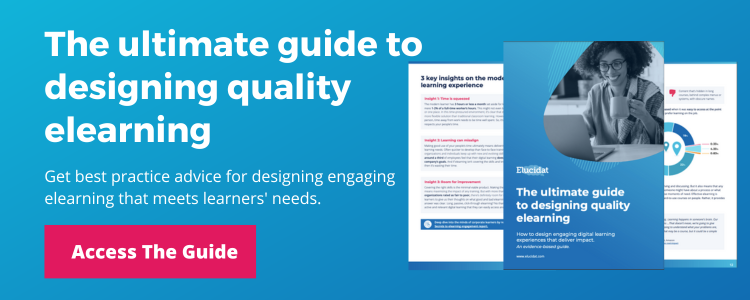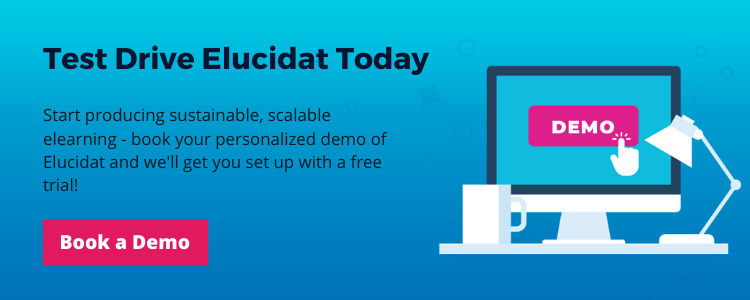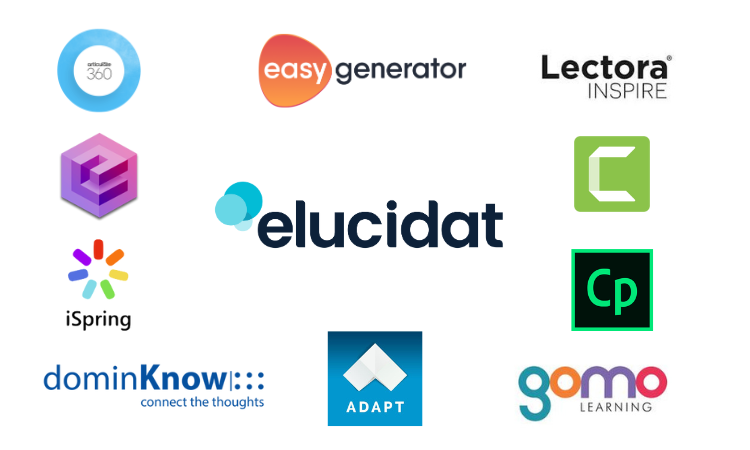Top 10 best elearning examples to inspire you
7 minute read
We support hundreds of elearning projects across all our customers and, if there’s one thing we’ve learned, it’s that each project is unique. Each course has a specific goal and audience that determines the design approach. We’ve rounded up 10 of the best elearning examples – each perfect for different goals and audiences – to give you fresh ideas for engaging with your audience. Get inspired with these expert examples of digital learning!
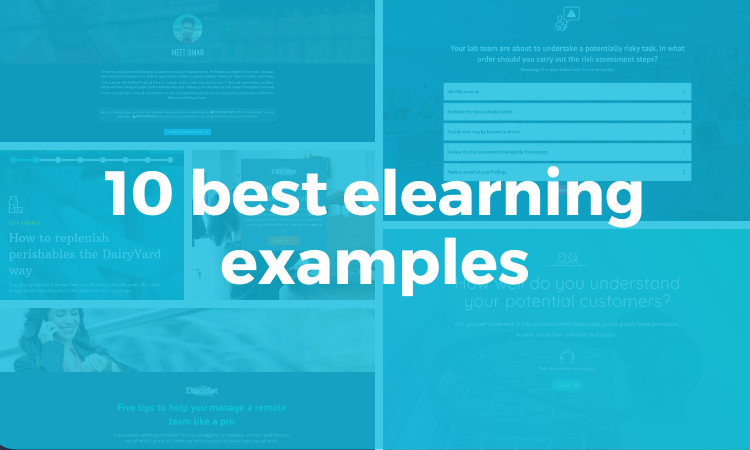
Here are the 10 best elearning examples to engage your audience and enhance your elearning.
-
Game-like quiz
Creating a sense of play in your corporate elearning is great for engagement, and easy to achieve through gamification. Fun, game-like product knowledge quizzes like the example below, are a great, interactive way to test a learner’s understanding.

Test this gamification example.
You can appeal to the learner’s competitive spirit by rewarding correct answers, as well as providing bonus questions with badges to collect. With this example of elearning, question rounds are used to emphasize increased difficulty using different points assigned to different questions. Learners are incentivized to apply their skills correctly, making the content more likely to stick in the learner’s mind when handling a real-life situation.
A great product training approach for:
- Learners who are motivated by competition.
- Content that involves high-pressure scenarios. Gamification is great for replicating this sense of pressure, or less serious topics that you can have a bit of fun with.
2. Microlearning
Microlearning can be an effective way to deliver learning in short bursts that fit with learners’ needs and busy schedules. It works well for learning on the job, at a moment of need, and as part of spaced learning, where users build up their learning over time through a series of microlearning topics. It can help drive long-term behavior changes in this context.
Quick briefing microlearning example:

Try this microlearning example.
Your employees are busy working whilst developing their skills, so providing information in a quick and easy way to digest is ideal. This microlearning setup helps you quickly explain the steps in a short and straightforward process. There’s space to give examples, ask questions and summarise key takeaways.
This is a great interactive elearning approach for:
- Employees working in busy environments with little time for elearning.
- A blended learning journey comprised of short bursts of elearning that can be taken at the learner’s own pace.
3. Simple branching scenario
Branching scenarios bring your content to life and give your learners the power to shape their own learning experiences. They also give learners the opportunity to make mistakes in a safe space, allowing them to explore consequences without causing actual harm or embarrassment. This makes them an obvious design choice for high-stake subjects, like navigating health and safety incidents.
Simple branching scenario example:
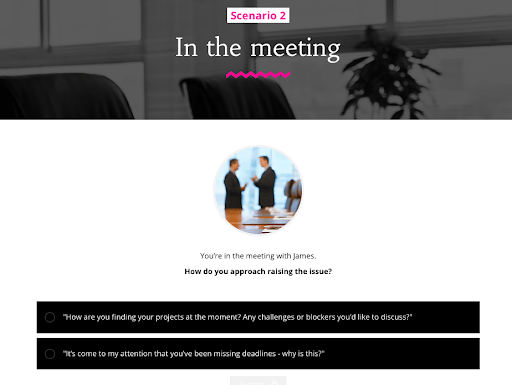
Giftable! | See this branching scenario elearning example
This example shows a simple, impactful way to build branching into your design. After making a decision in a scenario question, learners see the consequences of their right or wrong choice. They are then put back on the right path to continue the story and make their next decision. This simple branching scenario helps line managers tackle the most challenging situations to navigate, including addressing negative behavior change.
A great learning approach for:
- Giving context to policies and procedures to make them easier for learners to apply.
- Encouraging behavior change.
4. Case study with polls
Using social polls within elearning is useful to uncover new and challenging situations, such as dealing with difficult conversations as a line manager. Common challenges are identified to which line managers can compare their views with others and ensure they continue to respond in a fair manner. Real-life examples help to provide line managers with a range of strategies and tactics they can employ in their own situations.
Case study with polls example:
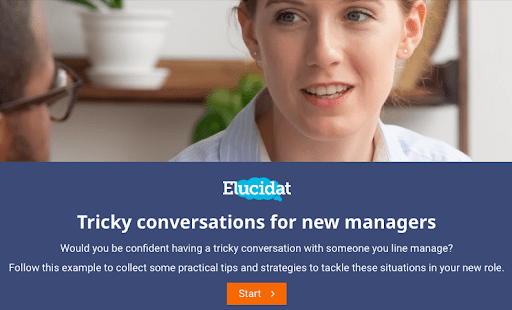
Try this interactive case study with polls now!
This case study course asks the learner to reflect on a situation that is unfolding. Social polling graphs follow each question, revealing how the learners peers answered. In the moment feedback explains what the right action to take would be and why.
Follow this example to collect some practical tips and strategies to tackle difficult situations in your new role, like having a tricky conversation with new managers.
A great learning approach for:
- Bringing skills-based content to life
- Exploring the nuances of challenging situations
5. Guided self-reflection
This personalized module encourages learners to stop, reflect, then commit to actions they’ll take forward on a specific topic.
Adding an element of social sharing and comparison to a learning experience appeals to the natural curiosity in all of us. Social polls are an effective way of sharing users’ responses with each other in an impactful – yet anonymous – way.
Guided self-reflection example:
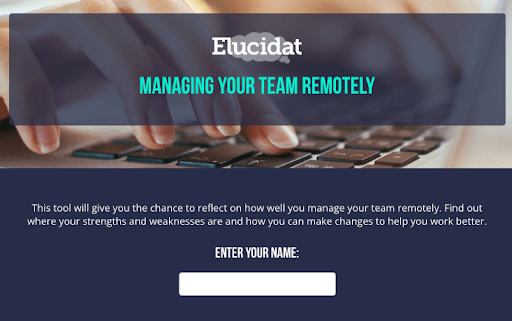
Try this self-reflection example for yourself!
This tool gives the learner the chance to reflect on how well they manage their team remotely, exploring where their strengths and weaknesses are and how they can make positive changes to their management technique.
A great learning approach for:
- Leadership and management training
- A reflective activity within a wider learning blend
6. Scenario-based policy training
Breaking down your training into short chunks goes a long way to holding learners’ attention and avoiding a situation where they click without reading. It also allows you to focus each chunk on a specific learning point or behavior, as you can see in this scenario-based policy training example.
Scenario-based policy training example:
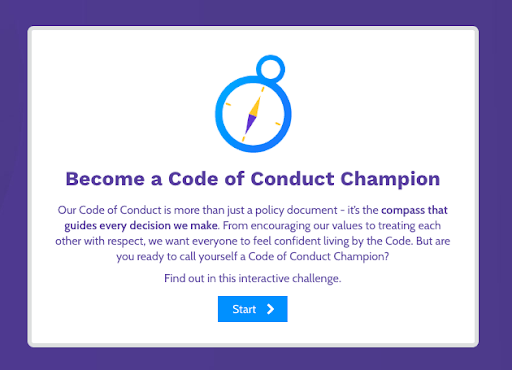
Giftable! | See this branching scenario elearning example
This non-linear design brings a Code of Conduct policy to life through bitesize scenario challenges, making it easy to digest. Learners are rewarded with badges for successful decision-making, adding to the overall learning experience, making it active not passive.
A great learning approach for:
- Making policies easier to relate to and implement in role.
- Learners who are incentivized through rewards.
7. Quick quiz
Quick assessments are great for gauging where your learners are and noting which learning modules people tend to struggle with. This can help see where further training is needed to overcome this knowledge gap.

Try this quiz example for yourself!
Here’s a classic knowledge check quiz designed to test a learner’s understanding and let them know how they scored. Choose whether to formally assess them or not.
A great learning approach for:
- Checking learners have understood key learning points.
- Weaving into a blended learning approach alongside knowledge and skills building.
8. In-depth process training
When learners need to get to grips with a process, it’s important to make training as simple to digest as possible. This top elearning example takes the learner through a step-by-step experience that breaks down a complex process into manageable chunks, explaining the ‘why’ as well as the ‘how’.
In-depth process training example:
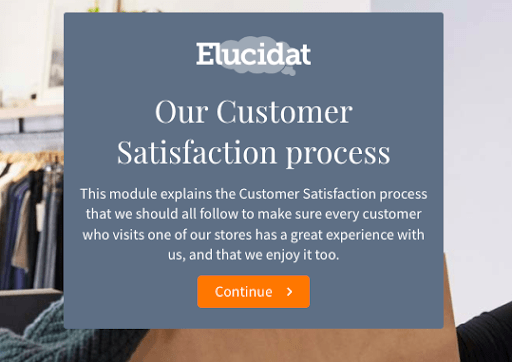
See this process training example
A non-linear approach using an easy-to-navigate menu is great for in-depth process training. It breaks the content into distinct topics that give an overview and then drills down into detail. It includes examples and knowledge checks, before helping learners embed and practise what they’ve learned with a scenario.
A great learning approach for:
- Training learners on a new process being introduced to the business.
- New employees as part of an onboarding flow.
-
In-depth learning: Onboarding
New starters have a lot to take in during those first few days in their role, but you can ease the learning curve by providing quick, focused overviews. A non-linear approach with a menu of short topics is great for upskilling learners on key tasks quickly. They can easily refer back to the content on their phones.

Try this onboarding example for yourself!
This example gets new hires and contractors ready to roll on their first day. It focuses on key subjects like company values, meeting the team, and FAQs. A range of interactions are used to bring this content to life, including videos and timelines.
A great learning approach for:
- New hires or contractors who need to get up to speed with tasks and equipment quickly.
- Short, focused processes with practical steps to follow.
-
Compliance test with question pools
Assessments are often critical, especially where compliance training is concerned. But how do you make sure they test your learners thoroughly enough? And how do you reduce the likelihood of sharing answers? Question pools are a great solution to making corporate elearning effective for all.
In this laboratory compliance test, question pools are used to create a robust assessment. Question pools mean that when a learner retakes the test, they’re unlikely to see the same questions again. This helps ensure learners truly understand the learning content – they won’t be able to simply choose a different answer on a second attempt. It also makes it harder for learners to share answers as it is unlikely their colleagues will have been posed the same set of questions.
Compliance test with question pools example:
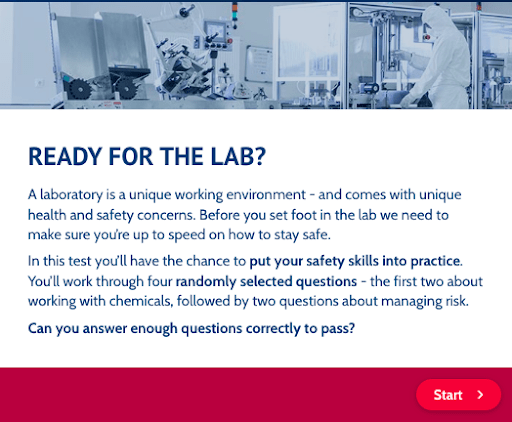
See this question pools example
In this test, learners will be given the chance to put their safety skills into practice. Working through four randomly selected questions – the first two about working with chemicals, followed by two questions about managing risk.
This elearning example is a great learning approach for:
- Business-critical content that needs to be tested, such as compliance rules and regulations.
- Audiences who need to prove a thorough understanding of a subject before starting a particular task.
Design impactful elearning with Elucidat
Looking for more elearning examples? Look no further than the Elucidat showcase, a place filled with an array of elearning examples designed for different audiences and goals.
Feeling inspired? Ready to create impactful elearning like this yourself? Start creating engaging, high-quality elearning with ease with Elucidat’s elearning authoring platform. Book a demo and a free trial today to see how the Elucidat platform can help you design impactful elearning courses.

